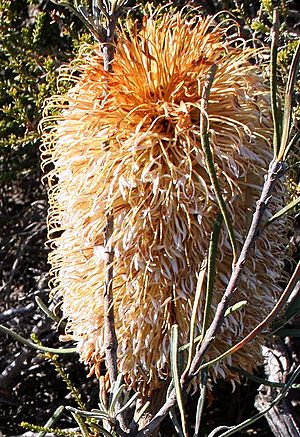Banksia subser. Sphaerocarpae facts for kids
Quick facts for kids Banksia subser. Sphaerocarpae |
|
|---|---|
 |
|
| Banksia grossa (Coarse Banksia), a species of B. subser. Sphaerocarpae | |
| Scientific classification | |
| Kingdom: | |
| (unranked): | |
| (unranked): | |
| Order: | |
| Family: | |
| Genus: | |
| Subgenus: | |
| Series: | |
| Subseries: |
B. subser. Sphaerocarpae
K.R.Thiele
|
Banksia subser. Sphaerocarpae is a scientific name for a group of Banksia plants. It was first suggested by a scientist named Kevin Thiele in 1996. However, another scientist, Alex George, later decided not to use this specific grouping in 1999.
Understanding Plant Families
Scientists use a method called cladistics to figure out how different plants are related. Think of it like building a family tree for plants. In 1996, Kevin Thiele and Pauline Ladiges studied Banksia plants using this method. They found some relationships that were different from what was commonly accepted.
Their study led them to suggest a new way to group Banksia species. They created a "family tree" (called a cladogram) that showed how these plants branched off from each other. This tree had a main branch that was similar to a group Alex George had already named, called B. ser. Abietinae.
This main branch then split into four smaller groups, and Thiele gave each of these smaller groups a subseries name. B. subser. Sphaerocarpae was one of these groups. It included the following plants:
|
|||||||||||||||||||
Naming and Grouping Plants
B. subser. Sphaerocarpae was officially described based on certain features of the plants. These features included how the cells on the inner part of their seeds were arranged. Another feature was how their old flower parts (called styles) curled around the seed pods.
Also, most species in this group, except for B. grossa, have a thin, papery plate between their seeds. The name Sphaerocarpae comes from the plant B. sphaerocarpa, which is also known as the Fox Banksia. This plant was chosen as the main example for the group.
One interesting finding was that B. sphaerocarpa var. dolichostyla (Ironcap Banksia) seemed quite different from other types of B. sphaerocarpa. Because of this, Thiele suggested it should be its own species, named B. dolichostyla.
Here's a simplified look at where B. subser. Sphaerocarpae fit in Thiele and Ladiges's plant arrangement:
- Banksia
- B. subg. Banksia
- B. ser. Abietinae
- B. subser. Sphaerocarpae
- B. grossa
- B. dolichostyla (now considered B. sphaerocarpa var. dolichostyla)
- B. micrantha
- B. sphaerocarpa
- B. subser. Sphaerocarpae
- B. ser. Abietinae
- B. subg. Banksia
Thiele and Ladiges's new way of grouping plants was used for a few years. But in 1999, Alex George published his own updated arrangement for the Banksia genus in a book series called Flora of Australia. He looked at some of Thiele and Ladiges's information but decided not to use their overall grouping. So, B. subser. Sphaerocarpae was no longer used. Also, B. dolichostyla was changed back to being a variety of B. sphaerocarpa.
New Discoveries
Since 1998, a scientist named Austin Mast has been doing more research using DNA information from Banksia plants. His studies suggest that the B. subser. Sphaerocarpae group might not be as closely related as once thought. This means it might be "polyphyletic", which is a fancy way of saying that the plants in the group don't all share a single common ancestor that isn't also an ancestor of plants outside the group.
For example, his research shows that B. micrantha and the varieties of B. sphaerocarpa are closely related. However, B. grossa seems more closely related to plants in a different group called B. subser. Leptophyllae. Also, B. dolichostyla appears to be more closely related to plants like B. violacea, B. laricina, and B. incana.
In 2007, Mast and Thiele started a new way of organizing Banksia plants. They moved a group of plants called Dryandra into the Banksia genus. They also created a new subgroup called B. subg. Spathulatae for species that have spoon-shaped cotyledons (the first leaves of a seedling). All the plants that were once in subseries Sphaerocarpae now fit into Mast and Thiele's B. subg. Spathulatae. Scientists are still working on a complete new arrangement for these plants as they gather more DNA information.

